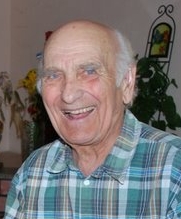Harald Nugiseks facts for kids
Quick facts for kids
Harald Nugiseks
|
|
|---|---|

Harald Nugiseks in 2009
|
|
| Born | 22 October 1921 Karjaküla, Särevere Parish, Järva County, Estonia |
| Died | 2 January 2014 (aged 92) Parnu, Estonia |
| Allegiance | |
| Service/ |
Estonia, Germany |
| Years of service | 1943–1945 Waffen-SS |
| Rank | Waffen-Oberscharführer (Corporal/Sergeant) |
| Unit | 20th Waffen Grenadier Division of the SS (1st Estonian) |
| Battles/wars |
|
| Awards |
|
Harald Nugiseks (born October 22, 1921, died January 2, 2014) was an Estonian soldier. He fought in World War II as a sergeant in the Waffen-SS. This was a special military branch of Germany's armed forces. Nugiseks is famous for being one of only four Estonian soldiers to receive the Knight's Cross of the Iron Cross. This was a very high military award for bravery.
Contents
Harald Nugiseks's Early Life and Military Service
Harald Nugiseks was born on a farm in Karjaküla village, Estonia. His parents were farmers. Harald went to a basic school in Laupa.
In October 1941, he joined an Estonian security battalion. Later, this unit became part of the German Waffen-SS during World War II. Nugiseks was part of the 185th battalion. This unit was used for security behind the main battle lines.
Joining the Estonian Legion
In 1943, Harald Nugiseks chose to join the Estonian Legion. This group was made of Estonian volunteers. They were sent to different battle areas. Nugiseks joined the 660th battalion.
By March 1943, his unit was fighting in Ukraine. They faced tough battles against Soviet forces. They fought in places like the Mius Front and later at Velikye Luki. By November 1943, Nugiseks had already seen a lot of fighting.
In February 1944, his group joined a famous German unit called the III (Germanic) SS Panzer Corps. This unit was known for its strong fighting skills. They faced many attacks from Soviet soldiers. The fighting was very hard and lasted for a long time.
Bravery at the Narva Front
Estonian volunteers fought along the Narva River against many Soviet soldiers. Even though they were outnumbered, the Estonians fought fiercely. They pushed back the Soviet forces.
Nugiseks earned the Knight's Cross of the Iron Cross for his bravery. He led an attack to capture a key area called the Vaasa-Siivertsi-Vepsküla bridgehead. His unit had lost many officers. So, Nugiseks stepped up to lead the attack.
New Tactics and Recognition
Harald Nugiseks changed their fighting plan. He loaded hand grenades onto sleds. This way, his soldiers did not have to crawl back for supplies over dangerous minefields. His platoon fought hand-to-hand using spades, grenades, and bayonets. They managed to secure the bridgehead.
Nugiseks's bravery was mentioned in official German reports. He also appeared in Signal magazine. He received his Knight's Cross award on April 9, 1944. He was only 22 years old. He was the first non-officer Estonian to receive this high honor. The ceremony was even filmed for propaganda.
Life After the War
After these events, Nugiseks faced some difficulties. He was briefly demoted after an argument with soldiers who were bothering Red Cross nurses. In September 1944, his home in Estonia was destroyed during a Soviet attack.
In May 1945, Nugiseks was captured by Czech fighters. He was held in a prisoner-of-war camp. After trying to escape three times, he was handed over to the Soviets. They sentenced him to ten years in the Gulag, which were forced labor camps. He also had to spend five years in Siberia.
Harald Nugiseks finally returned to Estonia in 1958. He worked as a laborer until he retired. In the 1970s, he built a house for his family with his own hands.
Later Recognition
On February 21, 1994, Harald Nugiseks's service to his country was officially recognized. He was made a Retired Captain of the Estonian Defence Forces. He was also honored by his community. In 2008, he received the Medal of Gratitude from the people of Estonia. This was for his fight against Bolshevism. After his death, a statue of him was placed at his old school.
See also
 In Spanish: Harald Nugiseks para niños
In Spanish: Harald Nugiseks para niños
- Battle for Narva Bridgehead
- Battle of Narva (1944)
- 20th Waffen Grenadier Division of the SS (1st Estonian)

